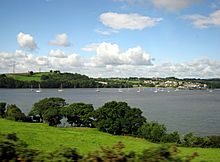Tamar–Tavy Estuary facts for kids
| Site of Special Scientific Interest | |

View across the Tamar estuary south of Bere Ferrers, looking towards Cargreen
|
|
| Area of Search | Cornwall, Devon |
|---|---|
| Coordinates | 50°24′41″N 4°12′12″W / 50.4113°N 4.2032°W |
| Interest | Biological |
| Area | 1,422.3 hectares (14.2 km2; 5.49 sq mi) |
| Notification | 1991 |
The Tamar–Tavy Estuary is a special natural area in England. It covers the parts of the River Tamar and the River Tavy where the river meets the sea. This area is found on the border between Cornwall and Devon.
It's called a Site of Special Scientific Interest (SSSI) because it's super important for nature. Part of it is also a nature reserve, looked after by the Cornwall Wildlife Trust. This place was chosen in 1991 because it has many different types of habitats. These habitats are home to lots of different birds and amazing sea creatures.
Contents
What is the Tamar–Tavy Estuary?
The Tamar–Tavy Estuary is a large area of land and water. It measures about 1,422-hectare (3,510-acre). This includes all the parts of the River Tamar that are affected by the tides. It stretches from Gunnislake down to the Tamar Bridge.
It also includes the River Tavy from Lopwell to where it flows into the Tamar. Other smaller rivers and marshy areas are part of it too. These include Kingsmill Lake and Tamerton Lake.
Why is this area so special?
This estuary is part of an even bigger protected area. It's called the Tamar Estuaries Complex Special Protection Area (SPA). This means it's important for birds across Europe.
It's also part of the Plymouth Sound and Estuaries Special Area of Conservation (SAC). This shows how important it is for different types of habitats and species.
The Cornwall Wildlife Trust helps protect parts of the estuary. They own a nature reserve near Kingsmill Lake. Lopwell Dam is another special spot, protected as a Local Nature Reserve.
Amazing Animals and Plants
The Tamar–Tavy Estuary is a very important place for nature. It's especially vital for birds that spend the winter here. Many different kinds of wildfowl (like ducks and geese) and wader birds come here.
Habitats and Plants
The lower parts of the estuary have wide, flat areas of mudflats. Next to these are salt marshes. These are grassy areas that get covered by salty water when the tide is high.
You can find special grasses here like common saltmarsh-grass and red fescue. There are also two rare types of grass: stiff saltmarsh-grass and bulbous foxtail.
Further upstream, where the water is less salty, you find different habitats. These include freshwater marshes and reedmarshes. Here, you might see the common reed. This area is also home to a very rare plant called triangular club-rush. It's the only place in the whole of the British Isles where it grows!
Birds of the Estuary
The mudflats are a favorite spot for many birds. More than 20% of the pied avocets that spend winter in Britain come here. These are beautiful birds with long, upturned beaks.
Other birds you might see in winter include:
These birds start arriving in October and stay until March.
Sea Creatures and Other Animals
The water in the estuary changes from salty to fresh. This mix creates a perfect home for many different sea creatures. You can find seaweeds, green algae, and many types of worms.
Near Calstock, there's a special shrimp called Palaemon longirostris. It has only been found in two other estuaries in Britain. The estuary is also one of only two places in the UK where the fish, allis shad, comes to lay its eggs.
Other amazing animals live in the quiet parts of the estuary. These include the European otter, a playful mammal. You might also spot the bright blue common kingfisher or tiny dormice.
Images for kids






